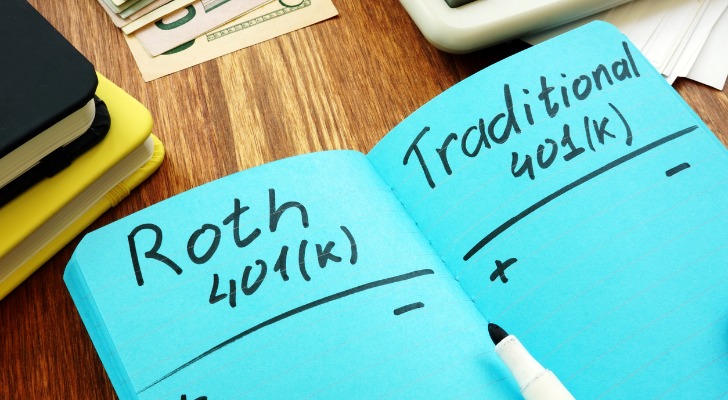A 401(k) plan can be a simple and effective way to save money for retirement on a tax-advantaged basis. While employers increasingly favor these defined contribution plans instead of traditional pensions, they aren’t all alike. There are different types of 401(k) plans companies can offer to employees and you may have more than one option for retirement savings. Understanding how the different 401(k) plans compare can help you decide which one is best for your savings goals. While valuable, a 401(k) should only be a part of your overall retirement savings plan.
A financial advisor can help you expand your plans based on your goals, timeline and risk profile.
What Is a 401(k) Plan and How Does It Work?
A 401(k) is a type of qualified retirement account. That means it follows special rules for contributions, withdrawals and taxation set by the Internal Revenue Code.
If you have a 401(k) at work, you have a defined contribution plan in which the amount you can withdraw is determined by the amount you contribute from your paychecks. This is different from a defined benefit plan in which the amount you can withdraw is based on your earnings and years of service.
Contributions to a 401(k) are made through elective salary deferrals so it’s up to you to decide what percentage of your income to put in. Your employer can also match some or all of those contributions, though this is optional rather than required.
A 401(k) can be funded with pretax or after-tax dollars. That’s one way to distinguish between different types of 401(k) plans since the way they’re funded can determine their tax treatment.
Types of 401(k) Plans Employers Can Offer
Employers can choose from several different options when offering 401(k) plans to employees. Those can include:
If you run a business of your own, you can also choose to set up a solo 401(k) for yourself. Employer-sponsored plans must adhere to IRS rules regarding contribution limits but they can also have their own rules when it comes to things like:
- Employee eligibility
- Waiting periods and enrollment
- Investment selection
- Matching contributions
- Hardship withdrawals
- 401(k) loans
- Vesting
For those reasons, it’s important to understand which type of 401(k) plan you have to better make the most of it.
Traditional 401(k)
A traditional 401(k) might be what you think of most often when you think of 401(k) plans. Here’s the basic rundown on how these plans work:
- Public or private employers of any size can offer them
- Employees contribute pretax dollars through elective salary deferrals
- Contributions reduce taxable income for the year
- Employers can offer matching contributions
- Qualified withdrawals are taxed at your ordinary income tax rate
The amount you can contribute to a traditional 401(k) is determined by the IRS. For 2026, the maximum salary deferral is $24,500 (up from $23,500 in 2025). If you’re 50 or older you can make an additional $8,000 catch-up contribution, which increases to $11,250 for those aged 60-63. The typical total limit on employer and employee contributions is the lesser of 100% of your compensation or $72,000 (up from $70,000 in 2025). These limits are subject to change from year to year.
Employers are required to file Form 5500, Annual Returns/Reports of Employee Benefit Plan each year to report plan information. You don’t have to report traditional 401(k) contributions on your taxes as they’re already deducted from your taxable income. But you would have to report withdrawals, including hardship withdrawals or unpaid 401(k) loans that are treated as distributions.
Roth 401(k) Plans

A Roth 401(k) plan combines features of a traditional 401(K) with some of the tax rules of a Roth individual retirement account. If an employer offers a Roth 401(k) they must also offer a traditional 401(k). No employee match is required, similar to a traditional 401(k), but employers can offer them if they choose to.
The contribution limits are the same for these plans so you can contribute $24,500 in 2026 ($23,500 in 2025) along with the $8,000 catch-up contribution if you’re 50 or older ($11,250 if you’re aged 60 – 63). A $72,000 total cap on contributions applies for 2026 (up from $70,000 in 2025). Filing requirements for employers remain unchanged from previous years.
Here’s how, at a glance, these plans work:
- Public or private employers of any size can offer them
- Employees contribute after-tax dollars through elective salary deferrals
- Contributions do not reduce taxable income for the year
- Employers can offer matching contributions
- Qualified withdrawals are generally tax-free
Safe Harbor 401(k) Plans
Safe harbor 401(k) plans are distinct from other types of 401(k)s in that employers aren’t required to pass nondiscrimination tests each year to offer them. Here are the basics of how safe harbor 401(k) plans work:
- Public or private employers of any size can offer them
- Employers are required to contribute to each employee’s plan, either on a matching or nonelective basis
- Employer contributions are required to be fully vested and guaranteed to employees
- Employees can make contributions up to the annual limits set by the IRS
- Employee contributions are deducted from taxable income
- Qualified withdrawals are taxed at ordinary income rates
Safe harbor 401(k) plans are similar to traditional 401(k)s when it comes to employer filing requirements and contribution limits. However, these plans are designed to ensure that all employees, not just those who are highly compensated, can participate in the plan in a meaningful way.
SIMPLE 401(k) Plans
A SIMPLE 401(k) plan is a retirement savings option designed for small business owners or self-employed individuals. Here’s an overview of how SIMPLE 401(k) plans work:
- Businesses with 100 or fewer employees can offer them
- Employees can make contributions up to the annual limits set by the IRS
- Employee contributions are made using pre-tax dollars
- Employers must also contribute to employee plans
- Qualified withdrawals are taxed at ordinary income rates
When setting up a SIMPLE 401(k) plan, employers must have it approved by the IRS first and explain the plan in detail to employees. The employer can’t offer any other type of retirement plan alongside a SIMPLE 401(k) and they have to file Form 5500 with the IRS each year.
The contribution limits for these plans are not the same as other types of 401(k) plans. For 2026, employees can contribute up to $17,000 (up from $16,500 in 2025) with an additional $4,000 catch-up contribution allowed for employees aged 50 or older.
Solo 401(k) Plans
A solo or individual 401(k) plan is designed for business owners and self-employed individuals who have no employees, other than their spouse. Here’s how these plans work:
- Available to sole proprietors, self-employed individuals and small business owners who employ no one other than their spouses
- Plan owners can make contributions as an employer and employee
- Contributions are tax-deductible
- Qualified withdrawals are taxed as ordinary income
For 2026, you can contribute up to $24,000 ($23,500 in 2025) or 100% of compensation, whichever is less, as an employee. You can also contribute up to 25% of your compensation as an employer unless you’re self-employed. In that case, you’d need to calculate maximum contributions based on net earnings from self-employment after deducting one-half of your self-employment tax and contributions for yourself.
Catch-up contributions of $8,000 are allowed if you’re 50 or older ($11,250 if you’re aged 60 – 63 in 2026) and total contributions can’t exceed $72,000 for 2026 ($70,000 for 2025). You’ll need an Employer Identification Number (EIN) to set up a solo 401(k) for yourself and you’ll have to file Form 5500-EZ, Annual Return of One-Participant (Owners and Their Spouses) Retirement Plan with the IRS each year.
Combining Multiple 401(k) Plans

If you have several different types of 401(k) plans because you’ve changed employers, combining them into a single retirement account may be something you’re interested in. This is something you can do through a 401(k) rollover. It essentially involves creating a new retirement account through a brokerage and rolling assets from all of your existing 401(k)s into it.
There are some benefits to rolling over multiple 401(k) plans into a single account, starting with the potential for lower fees. The less you pay in fees, the more you get to keep from your investment earnings year over year. It’s also easier to see your portfolio and assess investment performance when everything is in one place. And tax filing may be less stressful when you have a single 401(k) plan to account for.
If you’re interested in rolling over one or more 401(k) plans, consider talking to your financial advisor about the next steps. While a rollover is relatively simple to complete, making a mistake could end up triggering an unintended tax bill so it helps to have a professional guide you through it.
Bottom Line
There are many types of 401(k) plans to choose from and one may be a better fit for you than another, based on your financial situation. Understanding the tax treatment for each type of plan as well as contribution limits and eligibility requirements can help you decide which one may be the right choice. Making sure you follow the rules, as well as getting help with the choice of plans, can be done by seeking the guidance of a professional.
Tips for Investing
- Finding a financial advisor doesn’t have to be hard. SmartAsset’s free tool matches you with vetted financial advisors who serve your area, and you can have a free introductory call with your advisor matches to decide which one you feel is right for you. If you’re ready to find an advisor who can help you achieve your financial goals, get started now.
- SmartAsset’s investment calculator can help you see what your investments might look like down the road.
Photo credit: ©iStock.com/Credit:mj0007 , ©iStock.com/designer491, ©iStock.com/gustavofrazao
